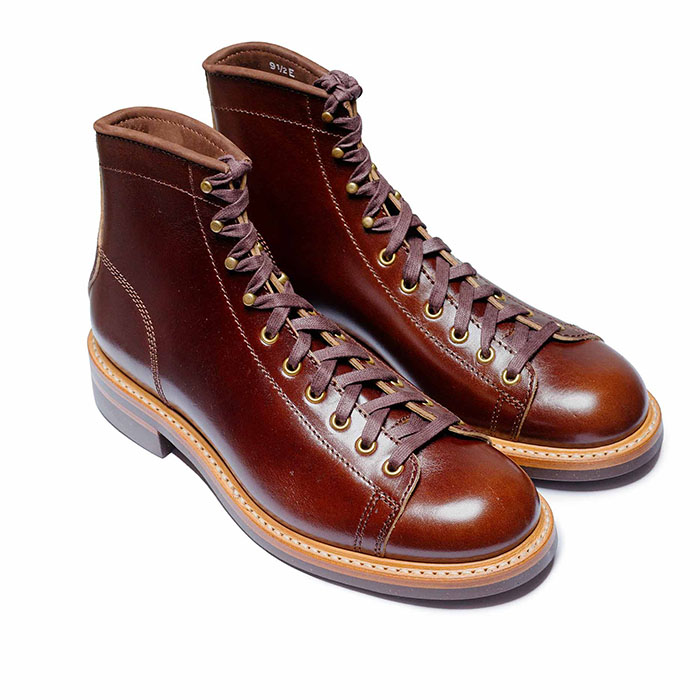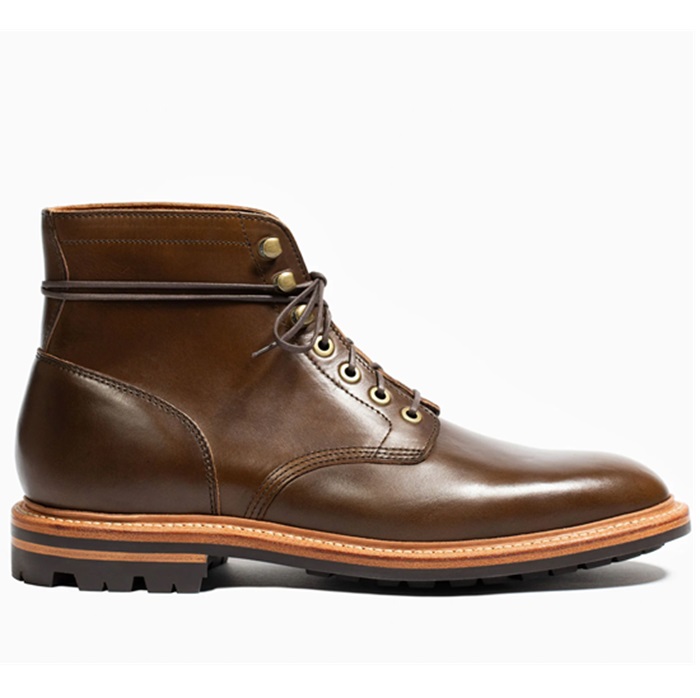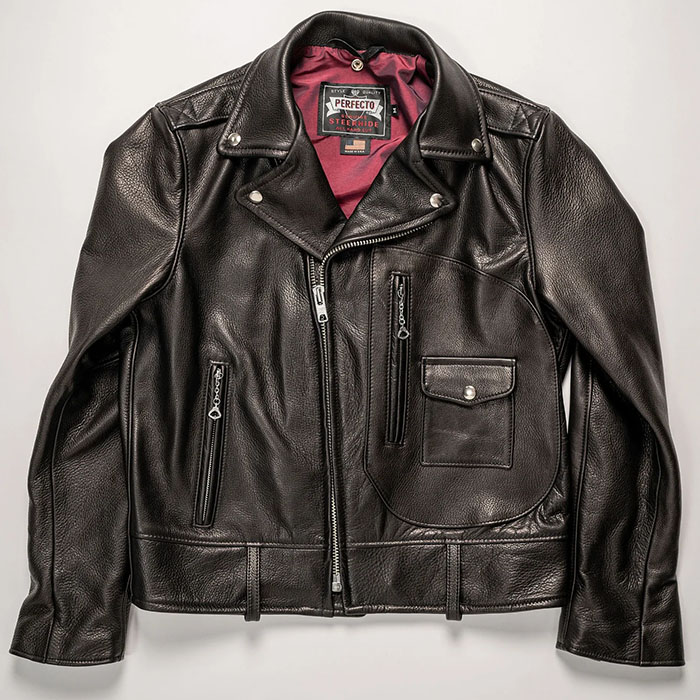Want to buy or sell something? Check the classifieds
-
The Fedora Lounge is supported in part by commission earning affiliate links sitewide. Please support us by using them. You may learn more here.
You are using an out of date browser. It may not display this or other websites correctly.
You should upgrade or use an alternative browser.
You should upgrade or use an alternative browser.
Lost Worlds horsehide vs Aero CXL horsehide
- Thread starter Titus
- Start date
El Marro
My Mail is Forwarded Here
- Messages
- 3,814
- Location
- California
LW heavy horsehide (the 4 oz + stuff) is somewhat unique in my experience. It is quite pliable, despite its thickness, and therefore you can stand to wear it when it is new and with a bit of wear it gets even easier. Still always feels like a suit of armor though.
It does not have any of the pull-up or depth of color that you get with CXL but I feel it is much better suited for jackets than CXL ever was.
It does not have any of the pull-up or depth of color that you get with CXL but I feel it is much better suited for jackets than CXL ever was.
panigale
Familiar Face
- Messages
- 67
I have multiple examples of both.
The Lost Worlds tends to show scratches less than the CXL.
The CXL will show a bunch more of the brown underneath over time.
The Lost Worlds tends to show scratches less than the CXL.
The CXL will show a bunch more of the brown underneath over time.
Featured products
-
 John Lofgren Monkey Boots Shinki Horsebuttt - $1,136 The classic monkey boot silhouette in an incredibly rich Shinki russet horse leather.
John Lofgren Monkey Boots Shinki Horsebuttt - $1,136 The classic monkey boot silhouette in an incredibly rich Shinki russet horse leather. -
 Grant Stone Diesel Boot Dark Olive Chromexcel - $395 Goodyear welted, Horween Chromexcel, classic good looks.
Grant Stone Diesel Boot Dark Olive Chromexcel - $395 Goodyear welted, Horween Chromexcel, classic good looks. -
 Schott 568 Vandals Jacket - $1,250 The classic Perfecto motorcycle jacket, in a very special limited-edition Schott double rider style.
Schott 568 Vandals Jacket - $1,250 The classic Perfecto motorcycle jacket, in a very special limited-edition Schott double rider style.
AeroFan_07
I'll Lock Up
- Messages
- 6,058
- Location
- Iowa
Apples to Oranges.
Here, read the actual text from Lost Worlds on these jackets:
https://lostworldsinc.com/Motorcycle_Jacket_Horsehide_Leather_Cafe_Racer.htm
https://lostworldsinc.com/Buco_J23_Horsehide_Leather_Motorcycle_Jacket.htm
Here, read the actual text from Lost Worlds on these jackets:
https://lostworldsinc.com/Motorcycle_Jacket_Horsehide_Leather_Cafe_Racer.htm
https://lostworldsinc.com/Buco_J23_Horsehide_Leather_Motorcycle_Jacket.htm
Last edited:
El Marro
My Mail is Forwarded Here
- Messages
- 3,814
- Location
- California
It is about as close to waterproof as you can get without gore Tex. I once wore mine out for a 30 minute walk in steady rain. When I got home, I was somewhat amazed to see that no water had leaked through the jacket, only a bit had come in between my neck and the collar where you would expectAny ideea if it's waterproof , LW hh?
TartuWolf
One Too Many
- Messages
- 1,748
- Location
- Tartu, Estonia
I haven't handled a proper LW jacket, but the impression I got from seeing a lot of them online is that they are super utilitarian and usually quite pigment heavy for water resistance, abrasion protection and overall robustness. CXL is on the other side of the spectrum - spray dyed and aniline. CXL get's it's water resistance (and robustness, stiffness to some degree) from the wax content - it's super wax heavy. LW leather would likely be much more "dry", at least in terms of waxes content.
Correct me if I'm wrong!
In my opinion you don't get LW for the beauty of a boutique style leather - you get it for the robustness, heft, protection it offers. Sure you can still get some lovely striations (I ADORE those) and grain popping, but that's rather secondary.
While CXL is the opposite - usually you get it for the sheer beauty and just accept it's flaws (like waxes hardening in the cold, get scratched by autumn leaves assaulting it during windy days...).
So LW to me is much more akin to Vanson, while (Aero) CXL is much more akin to something like Thedi or some of the JP aniline stuff.
Correct me if I'm wrong!
In my opinion you don't get LW for the beauty of a boutique style leather - you get it for the robustness, heft, protection it offers. Sure you can still get some lovely striations (I ADORE those) and grain popping, but that's rather secondary.
While CXL is the opposite - usually you get it for the sheer beauty and just accept it's flaws (like waxes hardening in the cold, get scratched by autumn leaves assaulting it during windy days...).
So LW to me is much more akin to Vanson, while (Aero) CXL is much more akin to something like Thedi or some of the JP aniline stuff.
TartuWolf
One Too Many
- Messages
- 1,748
- Location
- Tartu, Estonia
Would be very surprising if it wasn't. I'm pretty sure Stu would scoff at "tea-core" style leathers.Is LW hh dyed through ?
bigmanbigtruck
Practically Family
- Messages
- 594
Yes, it is dyed-through. Of course, there can be variations in how deep the dye penetrates due to the density of the hide. It's an art, not science.
And it's as waterproof a jacket as I have come across. I was dumb enough to wear one of mine out in a storm. While everything else I was wearing got drenched, nothing went through the jacket except around the neck/collar area as mentioned.
And it's as waterproof a jacket as I have come across. I was dumb enough to wear one of mine out in a storm. While everything else I was wearing got drenched, nothing went through the jacket except around the neck/collar area as mentioned.
ChewingWax
A-List Customer
- Messages
- 311
- Location
- Buffalo
And, as an added bonus, LW horsehide doesn't stiffen up in the cold like CXL, which is usually when you wear a jacket... so.
bigmanbigtruck
Practically Family
- Messages
- 594
I think it would be more productive if you try to ask the majority of your questions in one go rather than a slow-drip.Is LW hh more similar to the hh of the 1940s and 1950s ?
But to answer your question, that seems to be the consensus. The owner (Stuart) is very knowledgeable about jackets from that era and has a bunch of originals at hand. He's obsessed with recreating that kind of leather to the point of forming his own tannery.
Is LW hh more similar to the hh of the 1940s and 1950s (hh from USA that is) ?
No. Stu says himself his stuff is stronger than the originals.
No one was using hides that thick for jackets back in the day, except a few Cals. Aero ushered in this era of super heavy hides on jackets, but it's not what people were wearing in the heyday.
The closest hides I've worn to my vintage ones from those days are Schott's 6-series steerhide/horsehide and Aero's "Jerky" and goat.
bigmanbigtruck
Practically Family
- Messages
- 594
This is true, concerning his leather that's 4oz and up - but they will still form a lot of nice graining like the originals do.No. Stu says himself his stuff is stronger than the originals.
No one was using hides that thick for jackets back in the day, except a few Cals. Aero ushered in this era of super heavy hides on jackets, but it's not what people were wearing in the heyday.
The closest hides I've worn to my vintage ones from those days are Schott's 6-series steerhide/horsehide and Aero's "Jerky" and goat.
From discussing with him, he'd liken the originals to use HH closer to his 2.5-3oz grade stuff.
They still have a more robust topcoat.
This is true, concerning his leather that's 4oz and up - but they will still form a lot of nice graining like the originals do.
From discussing with him, he'd liken the originals to use HH closer to his 2.5-3oz grade stuff.
They still have a more robust topcoat.
The chrome tannage (and consequent water resistance) are a shared characteristic with the vintage stuff, but the sheer thickness of LW and CXL hides, or the even thicker ones special ordered from Johnson by TFL members, puts them in a different category.
bigmanbigtruck
Practically Family
- Messages
- 594
Not wrong, but the question was phrased as:The chrome tannage (and consequent water resistance) are a shared characteristic with the vintage stuff, but the sheer thickness of LW and CXL hides, or the even thicker ones special ordered from Johnson by TFL members, puts them in a different category.
It's definitely more similar to 40s-50s HH than CXL is.Is LW hh more similar to the hh of the 1940s and 1950s (hh from USA that is) ?
Similar threads
- Replies
- 22
- Views
- 3K
Members online
- Peacoat
- Daniel San
- Xysterz
- Justsomedude
- Darrell2688
- Eagledog
- StoryPNW
- jeffgarf
- Will Zach
- jfan
- hardlyworkingman
- minimatty
- rogueclimber
- Gary in NC
- quikrick
- dublinprem
- Whitters
- Tyler Durden
- Shawnziee
- AerGuitar
- TZRZ421
- Modified_last_call
- Evan1996
- Igneous629
- mr.hatlover
- erwinkn
- JackBroChill
- Pandakill
- Nick M68’
- Cooldude_abe
- churam88
- Cane sciolto
- Grasp loo paper
- Leather Canary
- JasonY
- unhatted
- Woolwonders
- BarryMcCockiner_PhD
- photo2u
- TheHamPimp
- Daniiel
- Camel24hrs
- DonR
- Mormus
- Dortreo
- Jaymig926
- Squarewave
- Kaiden
- Nickelman2005
- Bercor
Total: 2,634 (members: 72, guests: 2,562)